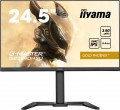Size
Diagonal size of the monitor matrix, in inches.
This parameter is one of the most important for any screen — it determines the total size of its working area. In general, it is believed that larger monitors are more comfortable: a large screen allows you to see a large fragment of text, images, etc. without having to scroll the "picture". On the other hand, the diagonal directly affects the dimensions, weight and cost of the monitor. In addition, it is worth remembering that screens with the same diagonal can have different aspect ratios and different specializations: for example, widescreen models are convenient for playing games and watching movies, while classic
4:3 or 5:4 solutions are preferable for working with documents. Now there are monitors of different diagonals on the market, among them the most popular are:
19–20",
22",
23 – 24",
25 – 26",
27 – 28",
29 – 30",
32",
34" and
more.
Response time (GtG)
The time each individual pixel on the monitor takes to switch from one state to another. The
lower the response time, the faster the matrix responds to the control signal, resulting in less delay and better image quality in dynamic scenes.
Note that in this case, the gray-to-gray method is used (the time it takes to switch from 10% gray to 90% gray). Pay attention to this parameter if the monitor is specifically purchased for fast-paced games, movie watching, or other applications involving quick screen movements. However, there’s no need to chase the fastest models. It’s not often possible to discern the difference between
1 ms and
5 ms. For most scenarios,
monitors with a 4 ms response time will suffice. In any case, it’s best to rely on live impressions for a true comparison.
Response time (MPRT)
The parameter expresses how long an object moving in the frame is displayed on the screen until it completely disappears. The lower this indicator, the more realistic dynamic scenes look on the monitor. The reaction of the matrix to movements clearly shows the time of existence of the trail from the changing picture. The MPRT parameter is more dependent on the refresh rate of the monitor screen than on the pixel response time. To reduce its value, the Motion Blur Reduction (MBR) function is often used, which briefly turns off the backlight at the end of the time of dynamic frames in order to increase the clarity of dynamic scenes.
Screen swivel
The presence of
a swivel stand in the design of the monitor allows you to change not only the angle of the screen (of course everyone has it), but also its rotation to the right and left. The angle of rotation depends on the model, but anyway, even a slight deviation allows you to quickly adjust the position of the monitor to your needs.
Game Features
—
Aim. The ability to display crosshairs on the screen (usually in the centre) — moreover, due to the operation of the monitor itself, regardless of the game settings. This feature can be useful in some "shooters" — for example, if the game itself does not have a traditional crosshair and accurate shooting is possible only when using sights on weapons, or if some types of weapons do not provide crosshairs at all. On many monitors, the shape and/or colour of the crosshairs can be selected from several options.
—
Timer. Possibility to display time counter on the screen. This feature is designed mainly for real-time strategy, although it can be useful in other cases — for example, if a gamer tends to get carried away and forget that you need to stop the game in time. Usually, the timer scale is made translucent — this provides good visibility and at the same time does not interfere with the process.
—
FPS display. The ability to display the current frame rate on the monitor right during the game. This function allows you to control the load on the video adapter and makes it easier to select the optimal detail settings so that the game does not turn into a “slideshow” and at the same time the picture remains more or less high-quality. Note that the ability to display FPS is available in some games, but for a full guarantee it is better to have such a tool
...in the monitor itself.
— Highlighting dark areas. A function that allows you to increase the brightness of certain dark areas on the screen without "highlighting" the rest of the image. One of the most popular ways to use this feature is to detect enemies hiding in dark places.
